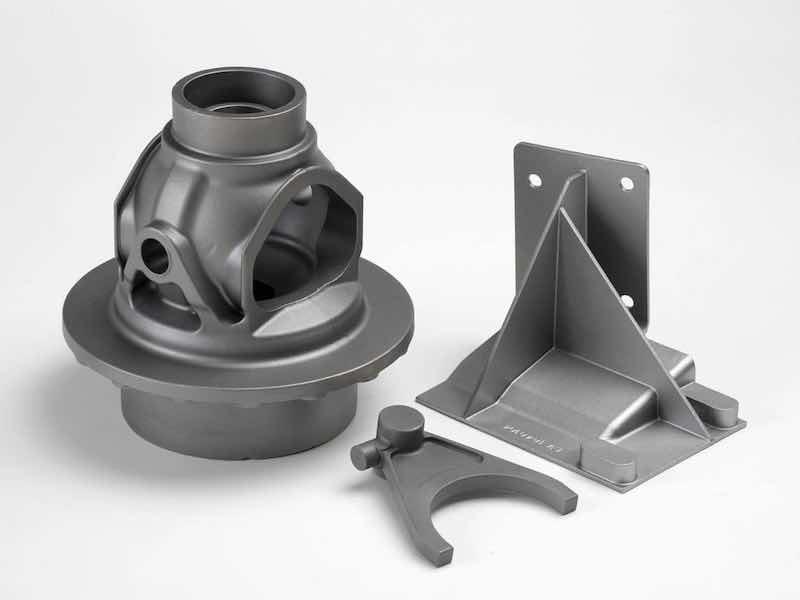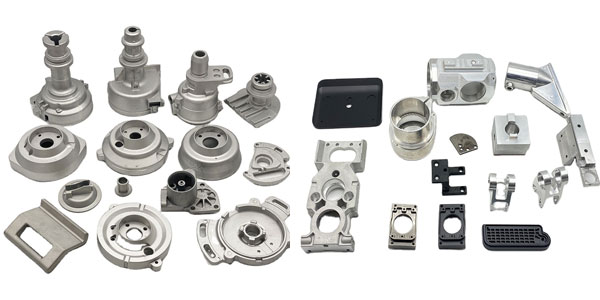Discovering the Versatile Makes Use Of and Applications of Light Weight Aluminum Castings in Modern Industries
Light weight aluminum spreadings have actually ended up being important to different contemporary markets due to their distinct homes. They use considerable advantages in weight reduction, thermal conductivity, and deterioration resistance. From vehicle advancements to applications in consumer products and building, their convenience is exceptional. The true extent of their impact expands past immediate advantages, hinting at more comprehensive ramifications for sustainability and performance. What exists ahead for aluminum castings in an ever-evolving commercial landscape?
Automotive Market Innovations
The auto sector has increasingly welcomed aluminum spreadings to improve lorry efficiency and effectiveness. By utilizing light weight aluminum, producers can generate lighter elements, which add to enhanced fuel economic situation and decreased exhausts. Secret applications include engine blocks, transmission instances, and architectural components, where the material's strength-to-weight proportion supplies toughness without including excess weight.
Light weight aluminum spreadings likewise provide exceptional thermal conductivity, which assists in much better warmth dissipation, thus boosting engine performance. Furthermore, advancements in casting modern technologies, such as die casting and sand casting, make it possible for the production of complicated geometries, enabling ingenious layouts that optimize area and capability.
The recyclability of aluminum aligns with sustainability goals in the vehicle sector, promoting ecologically pleasant techniques. As the sector remains to innovate, the use of aluminum castings is most likely to increase, driving more improvements in automobile style and performance.
Aerospace Applications and Developments
While the aerospace industry remains to focus on weight reduction and fuel performance, aluminum spreadings have actually arised as a vital material option for different applications. Their lightweight nature, combined with high strength-to-weight ratios, enables considerable enhancements in aircraft performance and efficiency. Light weight aluminum spreadings are generally used in architectural parts, such as body structures and wing components, where reducing weight is vital.
Recent developments in aluminum spreading innovations, including boosted alloy formulas and accuracy spreading methods, have actually better boosted the product's performance capabilities. These developments make it possible for the production of intricate geometries and complex designs while keeping structural honesty. Furthermore, aluminum's superb rust resistance guarantees durability and reliability in extreme aerospace environments.
As the aerospace market increasingly welcomes sustainability, aluminum spreadings offer a recyclable option that aligns with green practices, making them a crucial aspect in the growth of next-generation aircraft.
Consumer Item and Everyday Products
As consumers progressively look for lightweight yet long lasting materials for daily items, light weight aluminum castings have acquired appeal in various durable goods. The one-of-a-kind residential properties of aluminum, including its resistance to corrosion and outstanding thermal conductivity, make it an ideal choice for products like cooking equipment, household home appliances, and outside equipment. Aluminum cast pots and frying pans supply also warmth distribution, boosting cooking efficiency. Furthermore, making use of light weight aluminum in things such as bike structures and travel luggage assures an equilibrium between strength and portability. Suppliers appreciate aluminum castings for their flexibility, as they can be conveniently formed right into intricate shapes while maintaining structural integrity. The ability to recycle light weight aluminum without weakening its buildings straightens with expanding customer choices for lasting items. On the whole, light weight aluminum spreadings are indispensable to the manufacturing of durable, functional, and aesthetically pleasing consumer goods, fulfilling the demands of contemporary way of livings.
Building And Construction and Architectural Makes Use Of
Aluminum spreadings have actually ended up being an important part in building and architectural layout, especially due to their stamina and lightweight nature. These properties make light weight aluminum an excellent option for various applications, consisting of structural components, facades, and ornamental functions - Wisconsin Aluminum Foundry. Architects and home builders increasingly make use of light weight aluminum spreadings for window frames, doors, and roof, improving both functionality and appearances. The product's resistance to rust better extends its life expectancy, decreasing maintenance expenses and guaranteeing sturdiness in varied environmental problems
Moreover, aluminum can be conveniently molded into detailed styles, enabling innovative architectural expressions. Its adaptability promotes the creation of customized items that fulfill certain layout needs, from ornate railings to complicated supports. As sustainability ends up being a priority, aluminum's recyclability includes in its charm in eco-friendly construction practices. In general, aluminum castings are reinventing the building and construction sector by giving light-weight, sturdy, and aesthetically enticing remedies.
Electric and Electronic Elements
Aluminum spreadings play a vital duty in the production of lightweight electrical rooms, which enhance portability and performance in different applications. Furthermore, their excellent thermal conductivity makes them optimal for warmth sinks, ensuring peak efficiency and long life of electronic parts. Aluminum's conductive residential or commercial properties contribute to its use in numerous electric conductors, highlighting its relevance in modern-day technology.
Lightweight Electric Enclosures
Light-weight electrical enclosures play a crucial duty in securing sensitive digital components from ecological aspects and physical damage. Created from aluminum castings, these rooms are valued for their strength-to-weight ratio, making them excellent for different applications throughout markets. Their lightweight nature aids in decreasing total system weight, which is crucial in portable and mobile electronics. Light weight aluminum's corrosion resistance improves durability, prolonging the life-span of the enclosed elements. The capacity to mold aluminum right into intricate shapes enables for tailored designs, providing to details requirements while ensuring effective warmth dissipation. In addition, these units can be quickly incorporated right into existing systems, offering imp source versatility and versatility in contemporary technical settings. Overall, lightweight aluminum enclosures considerably add to the performance of electronic devices.
Heat Sinks and Conductors
While lots of products are made use of in electronic elements, light weight aluminum spreadings attract attention for their performance in heat management as heat sinks and conductors. Their excellent thermal conductivity enables effective warm dissipation, which is crucial in stopping the getting too hot of digital gadgets. Aluminum's lightweight nature even more enhances its suitability for applications where weight is a substantial aspect, such as in aerospace and automobile industries. Additionally, aluminum spreadings can be easily molded into complex shapes, offering style flexibility for optimizing thermal performance. The deterioration resistance of light weight aluminum additionally adds to the durability and reliability of these components in numerous atmospheres. check As modern technology advances and devices come to be much more compact, the demand for reliable warm administration remedies, like aluminum spreadings, remains to grow.
Marine Sector Use
The marine industry progressively counts on aluminum spreadings for their remarkable durability and corrosion resistance. These properties make light weight aluminum an optimal choice for numerous applications, including boat hulls, engine elements, and marine equipment. The lightweight nature of light weight aluminum castings enables boosted fuel performance and much easier maneuverability in watercraft, which is essential for both entertainment and commercial vessels.

Light weight aluminum castings additionally offer considerable price advantages due to their lengthy lifespan and reduced maintenance demands, minimizing the general functional costs for marine drivers. Additionally, the convenience of aluminum permits elaborate designs that can satisfy specific efficiency requirements.
Makers in the marine market utilize sophisticated spreading methods to generate complicated forms, guaranteeing that parts meet extensive safety and security and performance criteria. As the demand for high-performance aquatic vessels expands, aluminum spreadings are placed as an essential product in enhancing the capability and long life of aquatic tools.
Sustainability and Recycling in Aluminum Spreading

Light Weight Aluminum Recycling Process
Reusing light weight aluminum plays an important role in decreasing environmental effect and preserving resources within the spreading sector. The aluminum recycling process starts with the collection of scrap light weight aluminum, which can include old elements, manufacturing waste, and post-consumer items. This scrap is then arranged, cleaned up, and shredded right into small pieces to assist in melting.
As soon as prepared, the aluminum scrap is melted in a heating system at reduced temperature levels than key aluminum production, considerably reducing energy consumption. The molten aluminum is then cast into ingots or various other shapes for reuse in different applications - Wisconsin Aluminum Foundry. This closed-loop system permits the efficient recovery of aluminum, protecting its buildings while reducing the need for virgin products. The reusing procedure is an essential component of sustainable practices in light weight aluminum spreading.
Ecological Advantages
While aluminum casting plays an essential function in different markets, its environmental benefits are specifically impressive pertaining to sustainability and source conservation. The lightweight nature of aluminum adds to power effectiveness in transportation, reducing gas usage and emissions. Additionally, light weight aluminum casting promotes using recycled materials, significantly lowering the power required for production contrasted to main aluminum. This reusing procedure lessens waste and reduces the ecological effect associated with mining and refining resources. Additionally, aluminum is 100% recyclable without destruction of its buildings, advertising a sustainable lifecycle. By selecting light weight aluminum spreading, markets can considerably minimize their carbon footprint while promoting resource performance, making it a necessary choice in the quest of eco-friendly production methods.
Closed-Loop Equipments

Regularly Asked Questions
What Are the Secret Perks of Light Weight Aluminum Castings Over Various Other Products?
Aluminum spreadings offer lightweight residential or commercial properties, superb corrosion resistance, and high strength-to-weight ratios. They can be easily molded right into complicated forms, offer good thermal and electric conductivity, and are economical, making them better over many alternative materials.
How Is the Aluminum Casting Process Eco-friendly?
The aluminum casting procedure is eco-friendly as a result of its recyclability, reduced power usage, and minimized waste manufacturing. Its capability to use recycled materials reduces the carbon footprint, advertising sustainability within making techniques.
What Are Usual Obstacles in Light Weight Aluminum Spreading Production?
Common challenges in aluminum spreading production include maintaining dimensional precision, taking care of thermal tightening, preventing defects like porosity and incorporations, making certain proper mold and mildew layout, and maximizing production effectiveness while reducing product waste and environmental impact.
Exactly How Do Light Weight Aluminum Castings Contrast in Price With Other Production Techniques?
Aluminum spreadings usually offer affordable costs contrasted to other producing methods, specifically for tool to high-volume production. Their lower preliminary tooling expenses and reliable material usage can lead to favorable business economics in time.
What Future Fads Are Expected in Aluminum Spreading Technology?
Future fads in aluminum spreading technology are prepared for to include innovations in automation, enhanced alloy make-ups, enhanced reusing techniques, and the combination of 3D printing, all aimed at enhancing performance, decreasing prices, and reducing ecological impact.
Current advancements in aluminum spreading technologies, consisting of straight from the source boosted alloy formulations and accuracy spreading techniques, have additionally boosted the material's performance capacities. Aluminum castings have come to be an important element in building and construction and building design, especially due to their toughness and light-weight nature. The aluminum recycling process starts with the collection of scrap light weight aluminum, which can consist of old components, manufacturing waste, and post-consumer products. As soon as prepared, the light weight aluminum scrap is melted in a furnace at lower temperatures than main light weight aluminum manufacturing, greatly decreasing energy usage. Furthermore, light weight aluminum spreading promotes the use of recycled materials, greatly lowering the energy required for production compared to primary aluminum.